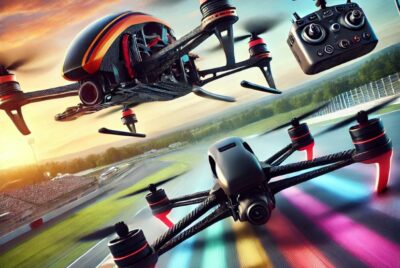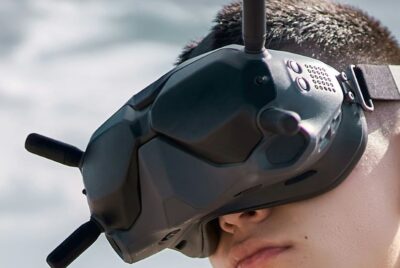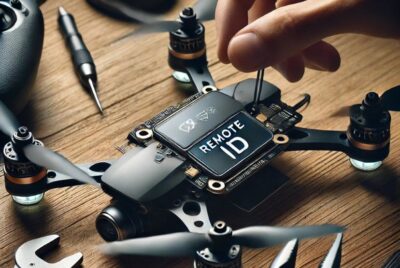Racing Drone Transmitter – Mastering Your Primary Connection
Hey there! Some links on this page are affiliate links which means that, if you choose to make a purchase, I may earn a small commission at no extra cost to you. I greatly appreciate your support! Please see our Disclosure to learn more.
Introduction
The Role of the Transmitter in Drone Racing
In the world of drone racing, the transmitter, also known as the radio controller, is your primary connection to your drone. It translates your hand movements and button presses into precise commands, allowing you to control your drone’s throttle, pitch, roll, and yaw. Mastering your transmitter is essential for achieving the level of control and finesse needed to navigate complex race courses and outmaneuver your competitors.
Understanding the Basics of Racing Drone Transmitters
At its core, a racing drone transmitter is a hand-held device that sends radio signals to your drone’s receiver, which then interprets those signals and controls the drone’s motors and other functions. Transmitters typically feature two main control sticks, along with a variety of switches, buttons, and dials that can be programmed to control various aspects of your drone’s performance.
Types of Racing Drone Transmitters
There are various types of transmitters suited for drone racing, each catering to different grip styles and preferences. Here’s a detailed look at the main types of drone racing transmitters:
Hybrid Grip Racing Drone Transmitters
Hybrid grip transmitters are versatile and popular among drone racers who may switch between different grip styles. These transmitters offer a balanced design that accommodates both pinch and thumb grips, making them ideal for pilots who haven’t settled on a single style or prefer the flexibility.
FrSky Taranis X9D Plus is a prime example of a hybrid grip transmitter. It’s known for its high level of customization, extensive features, and reliable performance. With a robust build and multiple switches, knobs, and sliders, it’s perfect for fine-tuning the drone’s behavior in-flight. Pilots appreciate its OpenTX firmware, which allows for significant customization of controls and telemetry feedback.
Another excellent hybrid grip transmitter is the Spektrum DX6e. This transmitter offers a comfortable design with precision gimbals and intuitive programming, making it suitable for various types of drones and flying styles. The flexibility it provides makes it a popular choice among both novice and experienced racers.
Pincher Grip Racing Drone Transmitters
Pincher grip transmitters are the most common style in drone racing. They feature two main control sticks that are manipulated using a pinching motion between the thumb and index finger. This grip style is favored by many professional drone racers because it can offer finer control and precision during races.
Futaba 18SZH is a top-tier transmitter favored by pinchers. Known for its high-resolution touch screen and extensive programming options, it allows for detailed adjustments to the flight characteristics. The precision of its gimbals and the quality of its build make it a reliable choice for competitive racing.
Another notable option is the Radiomaster TX16S. This transmitter is renowned for its versatility and extensive feature set, including hall sensor gimbals, multi-protocol support, and OpenTX firmware. It’s designed to provide a high degree of control and customization, catering to the precise needs of pincher grip pilots.
Thumb Grip Transmitters
Thumb grip transmitters are tailored for pilots who control the sticks using their thumbs only. This style is often preferred by those transitioning from gaming controllers, as it feels more natural for them. Thumb grip transmitters are usually designed to be compact and ergonomic.

The FrSky Taranis X-Lite Pro is a standout in this category. Resembling a game controller, it offers an ergonomic design that’s comfortable to hold and easy to use. Despite its compact size, it packs a powerful punch with full OpenTX support, adjustable gimbals, and comprehensive telemetry capabilities.
Pistol Grip Racing Drone Transmitters
While pistol grip transmitters are typically used in RC cars and boats, the DJI Motion Controller offers an entirely new way to fly. The intuitive motion control allows the aircraft to maneuver based on your natural hand motions, no complex buttons. Compatibility is currently limited to specific DJI models.
Selecting the right transmitter is crucial for drone racing success. Whether you prefer a hybrid, pincher, thumb, or less commonly, a pistol grip transmitter, each type has its unique advantages and caters to different flying styles. Understanding these options and choosing the one that best fits your grip style and racing needs will enhance your control and performance in competitive drone racing.
Key Features to Consider for Your Racing Drone Transmitters
Number of Channels
The number of channels your transmitter supports determines how many separate functions you can control. Most racing drones require at least four channels (throttle, yaw, pitch, and roll), but additional channels can be used for features like arming, flight mode selection, or camera control.
Gimbals and Sticks
Gimbals are the mechanisms that translate your stick movements into digital signals. Look for high-quality, precise gimbals with adjustable tension and smooth, responsive action. The shape and size of the sticks can also impact your comfort and control.
Switches and Buttons
Switches and buttons allow you to assign additional functions to your transmitter, such as arming your drone, changing flight modes, or activating features like beepers or LEDs. Consider the number, placement, and types of switches and buttons when choosing a transmitter.
Customization and Programming Your Racing Drone Transmitters
Most modern transmitters offer a high degree of customization and programming options, allowing you to tailor your setup to your specific preferences and flying style. Look for transmitters with intuitive, user-friendly interfaces and the ability to save multiple model profiles.
Frequency and Protocol
Ensure that your transmitter operates on a frequency band and protocol that is compatible with your drone’s receiver. Common frequencies include 2.4GHz and 900MHz, while popular protocols include FrSky, Crossfire, and FlySky.
Ergonomics and Build Quality
Since you’ll be holding your transmitter for extended periods, comfort and build quality are crucial. Look for transmitters with ergonomic designs, adjustable hand grips, and durable construction that can withstand the rigors of racing.
Popular Racing Drone Transmitter Options
FrSky Taranis X9D Plus

The FrSky Taranis X9D Plus is a popular choice among racers for its extensive customization options, intuitive interface, and compatibility with the widely-used FrSky protocol. It features high-quality gimbals, a large LCD screen, and a durable, ergonomic design.
Futaba T18SZ

The Futaba T18SZ is a high-end transmitter known for its exceptional build quality, precise gimbals, and advanced features. It supports multiple protocols and offers a wide range of programming options, making it a favorite among professional pilots.
Radiomaster TX16S

The Radiomaster TX16S is a versatile, feature-packed transmitter that offers excellent value for its price. It supports multiple protocols, features high-quality hall sensor gimbals, and runs on the open-source OpenTX firmware for extensive customization options.
Spektrum DX6e

The Spektrum DX6e is a user-friendly transmitter that offers a streamlined, no-nonsense approach to racing. It features a simple, intuitive interface, comfortable ergonomics, and compatibility with Spektrum’s DSMX protocol.
Jumper T-Pro V2

The Jumper T-Pro V2 is a versatile, multi-protocol transmitter that offers a wide range of features at an affordable price point. It supports both FrSky and Crossfire protocols, features high-quality gimbals, and runs on the open-source OpenTX firmware.
Setting Up Your Racing Drone Transmitter
Binding to Your Receiver
To control your drone, you’ll need to bind your transmitter to your drone’s receiver. This process varies depending on your specific equipment but typically involves putting both the transmitter and receiver into bind mode and following the manufacturer’s instructions.
Configuring Switches and Channels
Once your transmitter is bound to your receiver, you’ll need to configure your switches and channels to control your drone’s various functions. This may include assigning switches to arm your drone, change flight modes, or activate features like beepers or LEDs.
Setting Up Failsafe
Failsafe is a crucial safety feature that determines what your drone will do in the event of a lost connection with your transmitter. Setting up failsafe typically involves programming your receiver to cut the throttle and either hover in place or gently descend if signal is lost.
Updating Firmware
Keeping your transmitter’s firmware up to date is essential for ensuring optimal performance and compatibility with the latest features and protocols. Most transmitters can be updated using a USB connection and the manufacturer’s firmware update tool.
Mastering Your Racing Drone Transmitter Skills
Understanding Stick Movements
Mastering your racing drone transmitter starts with understanding how each stick movement affects your drone’s behavior. The right stick typically controls pitch (forward/backward) and roll (left/right), while the left stick controls throttle (up/down) and yaw (left/right rotation).
Practicing with a Simulator
Using a drone racing simulator is an excellent way to practice your transmitter skills without risking damage to your actual drone. Most simulators allow you to connect your transmitter via USB and offer a variety of realistic environments and physics to help you hone your control and muscle memory.
Developing Muscle Memory
Consistent practice is key to developing the muscle memory needed for precise, intuitive control. Focus on smooth, deliberate stick movements and gradually increase your speed and complexity as your skills improve.
Advanced Techniques and Tricks
As you become more comfortable with your transmitter, you can start experimenting with advanced techniques and tricks like split-S turns, power loops, and inverted yaw spins. These maneuvers require precise timing and coordination but can give you a competitive edge on the race course.
Troubleshooting Common Racing Drone Transmitter Issues
Loss of Control
If you experience a sudden loss of control, first ensure that your transmitter and receiver batteries are fully charged and properly connected. Check for any loose or damaged wires, and ensure that your failsafe settings are properly configured.
Interference and Glitches
Interference from other electronic devices, metal objects, or even other drones can cause glitches or erratic behavior. Ensure that you’re using a clear frequency channel and consider using a frequency hopping protocol like FrSky or Crossfire to minimize interference.
Stick Drift and Calibration
Over time, your transmitter’s gimbals may develop slight inconsistencies or drifting. Most transmitters feature a built-in calibration function that can help correct these issues. If the problem persists, you may need to replace your gimbals or have them serviced by a professional.
Battery and Power Problems
Ensure that your transmitter batteries are fully charged and in good condition. If you’re experiencing power-related issues, try using fresh batteries or a different brand. Some transmitters also allow you to adjust the battery voltage cutoff to prevent over-discharging.
Maintaining Your Racing Drone Transmitter
Cleaning and Storage
To keep your transmitter in top condition, regularly wipe down the exterior with a soft, dry cloth. Avoid using harsh chemicals or abrasive cleaners that could damage the finish or electronics. Store your transmitter in a cool, dry place away from direct sunlight and extreme temperatures.
Replacing Worn Parts
Over time, certain parts of your transmitter may wear out or become damaged, such as the battery cover, switches, or gimbal springs. Most manufacturers offer replacement parts that can be easily installed at home with basic tools.
Upgrading Gimbals and Modules
As your skills and needs evolve, you may want to consider upgrading your transmitter’s gimbals or adding new modules for features like telemetry or long-range control. Many transmitters feature modular designs that allow for easy upgrades and customization.
Conclusion
Mastering your racing drone transmitter is a crucial step in becoming a competitive and confident pilot. By understanding the different types of transmitters, key features to look for, and how to set up and maintain your equipment, you’ll be well on your way to unlocking your full potential on the race course. Remember, practice makes perfect – so spend time honing your skills, developing muscle memory, and pushing yourself to try new techniques and challenges. With dedication and persistence, you’ll soon be flying with the precision and finesse of a true racing drone master.
FAQs
- What’s the best transmitter for a beginner?
For beginners, look for a transmitter that offers a balance of ease of use, affordability, and room for growth. The FrSky Taranis X9D Plus and Radiomaster TX16S are popular choices that offer excellent value and a wide range of features. - How often should I replace my transmitter batteries?
The lifespan of your transmitter batteries will depend on factors like usage, storage conditions, and battery quality. As a general rule, replace your batteries if you notice a significant decrease in performance or if they’re more than a couple of years old. - Can I use my transmitter with multiple drones?
Yes, most modern transmitters support multiple model memories, allowing you to switch between different drones without having to rebind each time. Just be sure to double-check your failsafe and switch configurations before each flight. - What’s the difference between Mode 1 and Mode 2 transmitters?
The main difference between Mode 1 and Mode 2 transmitters is the location of the throttle control. Mode 1 has the throttle on the right stick, while Mode 2 has the throttle on the left stick. Mode 2 is more common in North America and Europe, while Mode 1 is more common in Asia and Australia. - How can I improve my transmitter’s range?
To improve your transmitter’s range, consider upgrading to a higher-gain antenna, using a frequency hopping protocol like FrSky or Crossfire, or investing in a long-range module like the TBS Crossfire or Frsky R9M. Ensure that your antenna is properly oriented and free from obstructions, and avoid flying in areas with high levels of interference.
Final Thoughts
Mastering your racing drone transmitter is a journey that requires patience, practice, and dedication. As you spend more time familiarizing yourself with the controls and developing muscle memory, you’ll find that your skills and confidence grow exponentially. Remember to start slowly, focusing on basic maneuvers and gradually increasing the complexity as you become more comfortable. Don’t be discouraged by setbacks or crashes; they are a natural part of the learning process and provide valuable opportunities for growth and improvement. Embrace the challenges, seek guidance from experienced pilots, and most importantly, enjoy the process of becoming one with your transmitter. With perseverance and a passion for the craft, you’ll soon be navigating the most demanding courses with finesse and precision. So, grab your transmitter, hit the track, and let your racing journey take flight!









